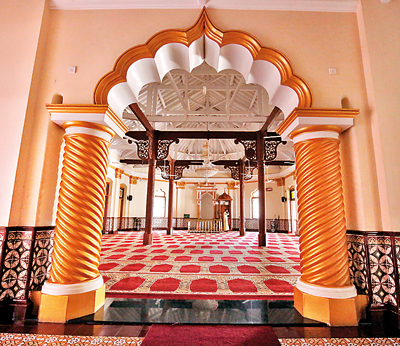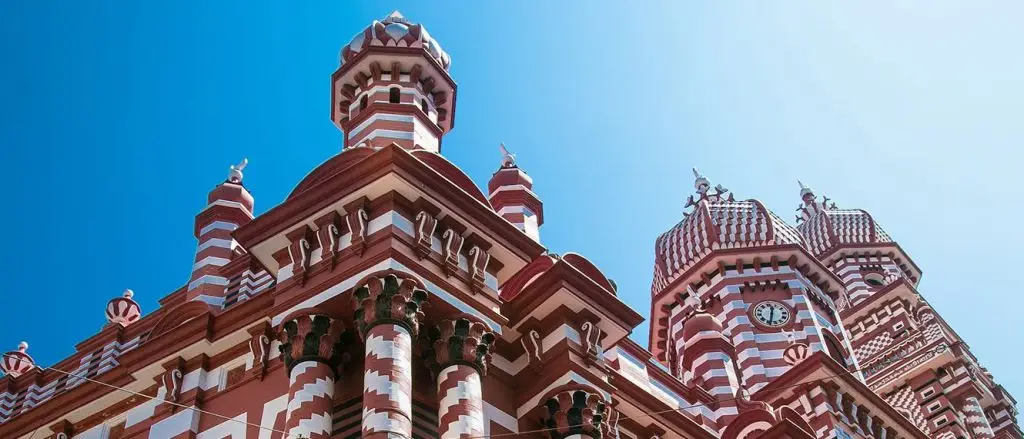Amongst the buzzing and thriving city of Pettah with the harbour at the backdrop lies one of the impressively beautiful structures enshrouding one who enters with an awe of serenity and tranquility.
The original Arabic name being Jami Ul-Alfar Masjid adorned at the entrance both in Arabic and English, the mosque is known by several name such as රතු පල්ලිය- Rathu Palliya which translates most obviously as Red Mosque, Sammankodu Pallivasal, known colloquially as the Samman Kottu Palli by the tamil speakers. The name Sammankodu Pallivasal is one of the oldest masjids build in during the 1st decade of the 20th century built by the Indian Muslim community based in Pettah to fulfill the Salah and community needs.
Brief History
The masjid was completed in 1909 designed and built by Habibu Lebbe Saibu Lebbe an unlettered architect was the master mind behind the structure which at the time could hold up to 1500 worshippers. However, later on in 1975 the Masjid was expanded to accommodate 10,000 worshippers to cater the needs of the public. History has it that the masjid used to be a visible landmark even from the sea that sailors would recognize from a distance however, with the high-rise towers in the vicinity of Colombo in present days, the Masjid has is concealed.
The Red Mosque
During Early Days
The present day
Being in a busy business hub, the red and white stiped masjid is an attraction amidst the great buzz and its more than obvious to see the sight of people rushing for prayers during the Salah times or Jumma prayers, hence if you are not comfortable with the rushing crowd, its best to avoid such times. The best part of this place is that anyone is welcome to visit the place and may also be provided with a guide to tour around the masjid.
attraction amidst the great buzz and its more than obvious to see the sight of people rushing for prayers during the Salah times or Jumma prayers, hence if you are not comfortable with the rushing crowd, its best to avoid such times. The best part of this place is that anyone is welcome to visit the place and may also be provided with a guide to tour around the masjid.
Some fun facts about the Masjid
- A Pomegranate shaped main dome depicting even the same colours.
- The mosque consists of 49 Minarets adding to its uniquely stunning structure.
- Indo-Saracen architectural design, encompassing both Indian and Islamic traditions.
- The 110 years old fully functional clock on the original dome brought from Ukraine.
- The old structure still remains with a new wing build behind to expansion projects.
- The stark colour, with each brick being hand-painted white or red in four different designs – checkered, jagged, striped or spiral.
- A pond with running water for purpose of Ablution (washing of face hands and legs before prayers).
- Men to have an attire that covers the body and below the knees.
- Female visitors are required to cover their hair, arms and legs before entering.
- Some of the busy times are prayer times and specially Friday Jummah prayers.
- The streets are busy most of the time with street peddlers, porters with heavy loads and shoppers as well.
- Best time to visit would be early morning when the streets are less crowded and less warm.
- For tour guides, you may be able to start of by 930am until 530pm.
Be mindful of your purchases as you may not find the best of products although may fulfil the need. Also keep an eye on your valuables as streets may be busy and a few black sheeps may cross your way.
No Entrance fee is charged at the Masjid
To know more about places to visit in Colombo, Click Here to check out our post.
How to reach
The Masjid is about 32 Km from the Bandaranaike International Airport and can take an hour to reach during busy hours.
If you are stationed in Colombo, you can travel by bus, train or a tuk tuk and saunter within the roads of Keizer Street, Main street and Cross streets to arrive at the premise that is located in 2nd Cross Street.
Jami Ul Alfar (Red Mosque): Best | Complete Travel Guide 2023 Read More »

